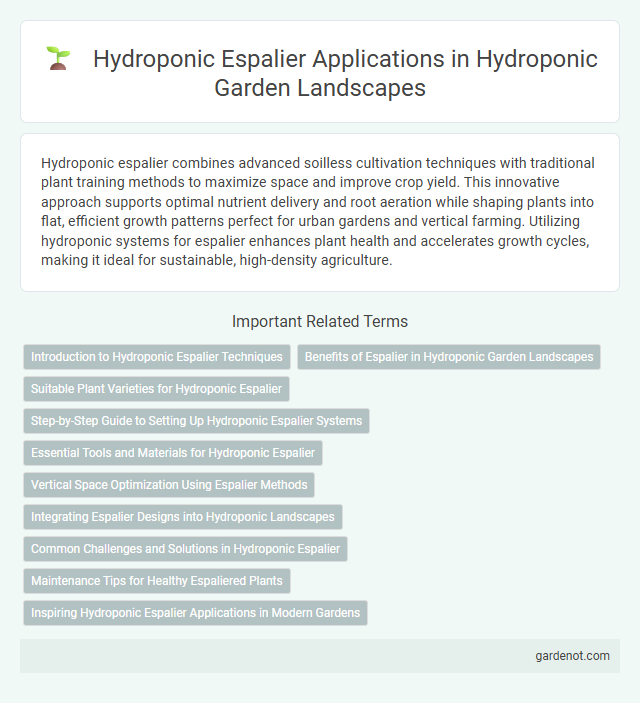Hydroponic espalier combines advanced soilless cultivation techniques with traditional plant training methods to maximize space and improve crop yield. This innovative approach supports optimal nutrient delivery and root aeration while shaping plants into flat, efficient growth patterns perfect for urban gardens and vertical farming. Utilizing hydroponic systems for espalier enhances plant health and accelerates growth cycles, making it ideal for sustainable, high-density agriculture.
Introduction to Hydroponic Espalier Techniques
Hydroponic espalier techniques combine traditional espalier training methods with soilless hydroponic systems to optimize plant growth and space utilization. This method allows precise control over water, nutrients, and light, promoting healthier plants and higher yields in limited areas. Implementing hydroponic espalier enhances vertical farming efficiency by streamlining airflow and improving pest management.
Benefits of Espalier in Hydroponic Garden Landscapes
Espalier in hydroponic garden landscapes maximizes space efficiency by training plants to grow flat against structures, enabling higher density planting and better air circulation. This method improves light exposure for each plant, enhancing photosynthesis and boosting overall yield in controlled environments. Additionally, espalier facilitates easier maintenance and harvesting, reducing labor costs and promoting healthier, more productive crops.
Suitable Plant Varieties for Hydroponic Espalier
Suitable plant varieties for hydroponic espalier include compact fruit trees such as dwarf apple, pear, and fig cultivars that exhibit strong branching and adaptability to controlled environments. Herbs like basil, thyme, and rosemary also thrive in espalier systems due to their manageable growth habits and high yield potential in hydroponic setups. Selecting plants with flexible stems and rapid growth cycles enhances training ease and maximizes vertical space efficiency in hydroponic landscapes.
Step-by-Step Guide to Setting Up Hydroponic Espalier Systems
Hydroponic espalier systems maximize vertical growing space by training plants along a structured framework using nutrient-rich water solutions. Begin by selecting a sturdy trellis or wire support system and choose fast-growing, espalier-suitable plants such as tomatoes or cucumbers for optimal nutrient absorption. Set up the hydroponic reservoir and pump system, regularly monitor pH levels (ideal range 5.5-6.5) and nutrient concentration, and maintain consistent pruning to encourage horizontal growth along the espalier framework.
Essential Tools and Materials for Hydroponic Espalier
Hydroponic espalier requires essential tools such as trellises, clips, and ties to support plant growth and maintain the desired shape. Quality hydroponic growing media like coco coir or perlite, along with nutrient-rich water solutions, are critical for optimal root development and plant health. Monitoring equipment such as pH meters and timers ensures precise control over nutrient delivery and environmental conditions.
Vertical Space Optimization Using Espalier Methods
Hydroponic espalier techniques maximize vertical space by training plants to grow flat against a support structure, increasing planting density and improving air circulation. This method reduces the footprint needed for crop production, allowing higher yields in limited areas such as urban gardens and greenhouses. Precise nutrient delivery and controlled environments in hydroponic systems enhance plant health while optimizing growth along the espalier framework.
Integrating Espalier Designs into Hydroponic Landscapes
Integrating espalier designs into hydroponic landscapes maximizes space efficiency by training plants to grow flat against structures, enhancing light penetration and air circulation. This method supports higher yield per square foot and allows precise nutrient delivery through hydroponic systems, promoting healthier plant development. Hydroponic espalier transforms vertical surfaces into productive growing areas, ideal for urban farming and modern sustainable agriculture.
Common Challenges and Solutions in Hydroponic Espalier
Hydroponic espalier faces common challenges such as nutrient imbalances, inadequate support structures, and inconsistent water supply that can hinder plant growth and yield. Solutions include precise monitoring of nutrient concentrations with advanced hydroponic sensors, implementing adjustable trellis systems for optimal plant training, and automating irrigation schedules using smart timers to maintain consistent hydration. Addressing these issues ensures healthier, more productive hydroponic espalier systems in controlled environment agriculture.
Maintenance Tips for Healthy Espaliered Plants
Hydroponic espalier plants require consistent monitoring of nutrient levels and pH balance to ensure optimal growth and prevention of deficiencies. Regular pruning and training of branches maintain the desired flat shape while improving air circulation and light exposure, reducing the risk of disease. Keeping the hydroponic system clean and inspecting for pests or algae buildup supports the long-term health and productivity of espaliered plants.
Inspiring Hydroponic Espalier Applications in Modern Gardens
Hydroponic espalier systems transform modern gardens by combining vertical farming techniques with soilless cultivation, maximizing space efficiency and plant growth. These innovative setups use nutrient-rich water solutions to support fruit trees and vines trained against structures, enhancing both aesthetics and yield without traditional soil. Gardeners achieve stunning geometric plant patterns while optimizing resource use and promoting sustainable urban agriculture.
Hydroponic espalier Infographic

 gardenot.com
gardenot.com